Key takeaways:
- Understanding seasonal trends requires a blend of intuition and data analysis to effectively shape marketing strategies.
- Tracking trends is essential for anticipating consumer behavior, staying competitive, and creating emotionally resonant campaigns.
- Adapting to trends involves flexibility and listening to customer feedback, which can lead to increased trust and loyalty.

Understanding seasonal trends
Understanding seasonal trends can feel like uncovering a fascinating layer of consumer behavior. I remember the excitement I felt during my first spring as a marketer—watching how people suddenly craved floral patterns and pastel colors. It’s almost magical to see how preferences shift with the seasons; one moment, everyone is decked out in winter blues, and then, almost overnight, they’re embracing the vibrant hues of summer.
When I think about the emotional connection we have with different seasons, it’s clear that our feelings play a big role in these trends. Isn’t it interesting how the warmth of the sun can evoke a sense of joy and adventure, leading us to purchase swimwear and outdoor furniture? Personally, I love the anticipation that fall brings, as it prompts a wave of pumpkin-spiced everything and cozy knits—I can’t be the only one who looks forward to that!
Delving deeper, I’ve found that understanding these trends requires a blend of intuition and data. For instance, analyzing previous years’ sales during the holiday season has taught me a lot about consumer sentiment. Are we not all influenced by the social cues of our surroundings? Nostalgia often plays a part too, shaping what makes a comeback each season. Isn’t it fascinating to think about how these trends reflect our collective psyche?
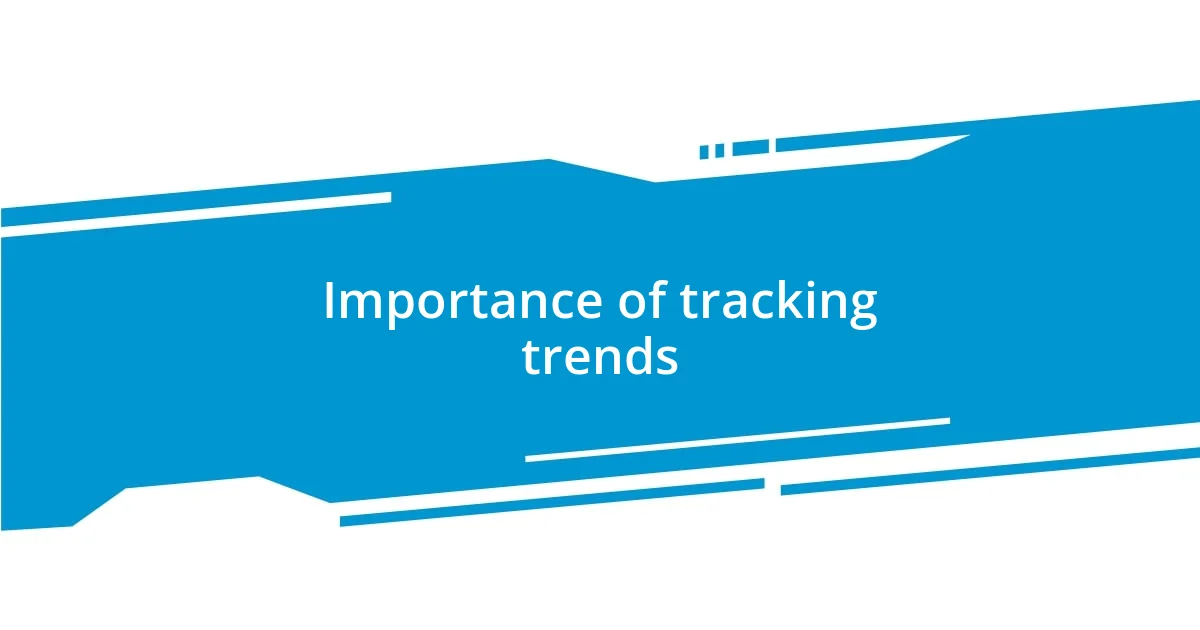
Importance of tracking trends
Tracking trends is crucial for staying ahead in the ever-changing marketplace. I remember when I first started monitoring seasonal trends and noticed how brands that adapted quickly to these changes often outperformed their competitors. For instance, in one spring campaign I coordinated, we tailored our offerings to emphasize eco-friendly products, which resonated significantly with our audience. Understanding when to pivot is key.
Moreover, data on seasonal trends helps us forecast future demands. Analyzing past trends not only reveals preferences but also allows us to anticipate shifts in consumer behavior. I once analyzed a trend where summer accessories surged in popularity every July, prompting a successful campaign that aligned with those expectations. The joy of seeing your predictions come to life is unparalleled.
Lastly, tracking seasonal trends allows for deeper connections with customers. By leveraging these insights, brands can create campaigns that truly resonate on an emotional level. Remember that winter holiday campaign where we featured family gatherings? The response was overwhelming, as it tapped into shared experiences. Engaging consumers emotionally can transform a simple product into a cherished memory.
| Aspect | Value |
|---|---|
| Predictive Power | Anticipates Consumer Behavior |
| Competitive Advantage | Stays Ahead of Rivals |
| Emotional Connection | Resonates with Consumers |
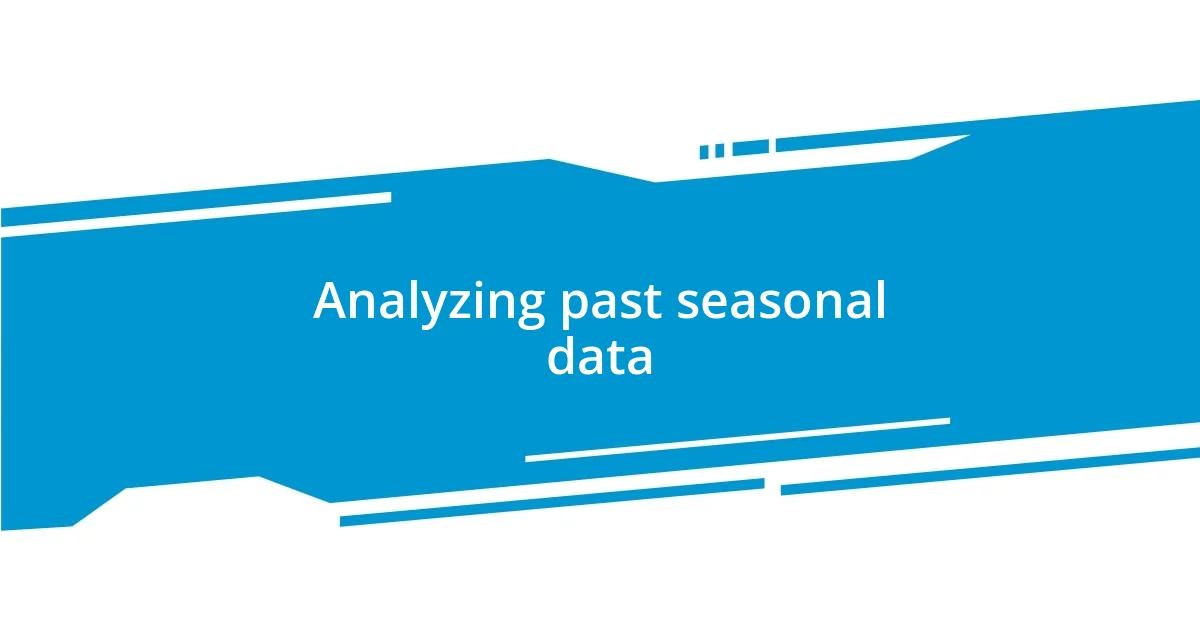
Analyzing past seasonal data
Analyzing past seasonal data feels like piecing together a puzzle; each piece reveals a story about consumer behavior. I recall a year when I meticulously reviewed our summer sales figures, searching for patterns. I noticed, for example, that certain beachwear items consistently spiked in popularity right after Memorial Day. This insight not only validated my gut feeling but also shaped our inventory decisions for the following summer, ensuring we capitalized on that early buying frenzy.
As I examined past seasonal data, several key elements stood out to me:
- Timing of Purchases: Identifying peak periods when consumers are most likely to buy.
- Product Preferences: Understanding which items tend to outperform others in specific seasons.
- Consumer Sentiment: Using data to gauge how emotions like nostalgia influence purchasing habits.
- Demographic Insights: Recognizing shifts in preferences across different age groups or locations.
- Economic Factors: Observing how outside factors, like economic downturns, can impact seasonal buying trends.
Reflecting on these elements helps hone my strategies for future campaigns. Each piece of data offers not just numbers, but meaningful insights into what truly drives consumers.
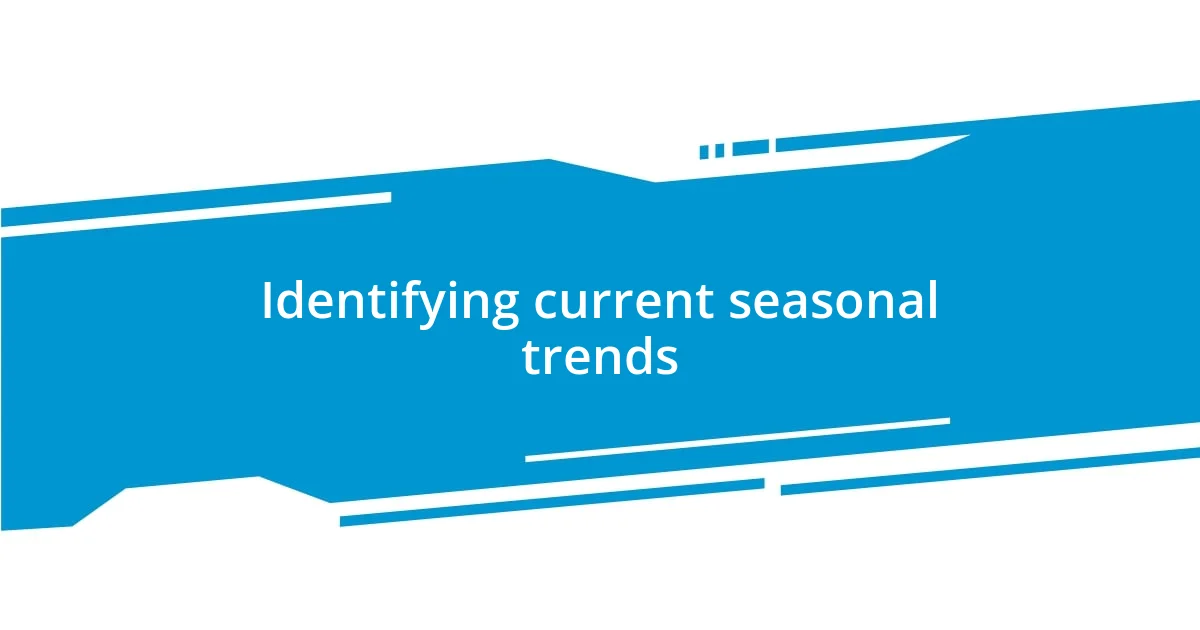
Identifying current seasonal trends
Identifying current seasonal trends starts with keen observation and a bit of intuition. I vividly remember a time when I stumbled upon an emerging interest in plant-based products during spring. By casually scrolling through social media, I noticed influencers promoting this lifestyle, which helped me realize that consumers were increasingly drawn to sustainability. Isn’t it fascinating how a simple observation can guide a whole marketing strategy?
In working with various brands, I’ve found that attending trade shows and local events can unveil seasonal insights. At one expo, I noticed a surge in colorful, eco-friendly packaging among several vendors. This led me to wonder: how might this shift influence consumer preferences going into the next quarter? It confirmed my belief that staying engaged in the community often reveals trends before they fully blossom in mainstream markets.
Lastly, analyzing social media engagement can be an eye-opener. I once tracked hashtag performance for various seasonal campaigns, and it became apparent that certain themes resonated more during the holidays. Seeing how specific posts generated excitement and conversations made me realize that consumers are looking for authentic connections. How often do we stop to think about what truly drives these seasonal spikes in interest? It’s not just about the products; it’s about the stories we share and the values we represent.

Predicting future seasonal shifts
When I think about predicting future seasonal shifts, I often reflect on how data can serve as our compass. One memorable moment was when I noticed an uptick in online searches for home fitness equipment during the early days of the pandemic. While everyone was adapting to life indoors, anticipating not only a seasonal surge but a cultural shift shaped my product recommendations for the entire year. How can we not learn from such dramatic changes?
Watching trends evolve in real-time is like participating in a dance, where every move counts. I remember attending a webinar where experts discussed the rise of minimalism, particularly in fashion, as we moved into fall. This insight pushed me to advocate for a capsule collection among my clients, which ultimately resonated with consumers seeking simplicity in a chaotic world. What drives someone to choose one style over another? Often, it’s a blend of emotional needs and societal tides.
Moreover, I find that predicting these shifts involves embracing ambiguity and being prepared for surprises. I once initiated a conversation with a friend who works in agriculture, and he shared how weather patterns have started moving unpredictably. This exchange opened my eyes to potential disruptions in seasonal cycles. Are we really equipped to adapt to these changes? For me, the answer lies in staying proactive, open to learning, and continuously engaging with various industries beyond my comfort zone.
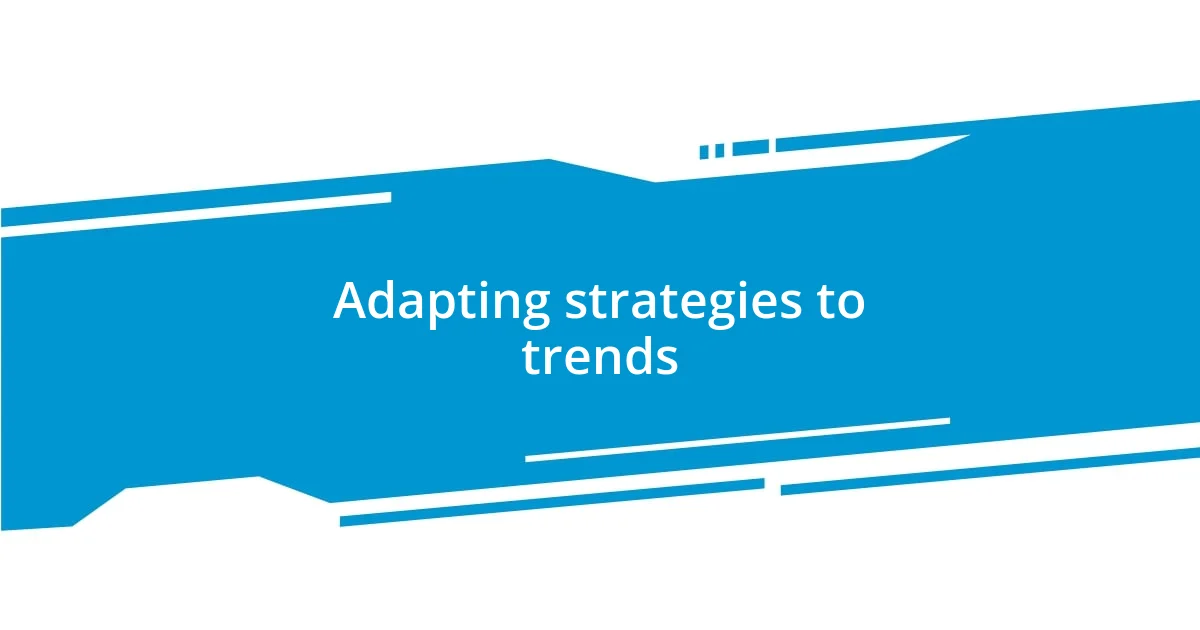
Adapting strategies to trends
Adapting strategies to trends requires agility and a keen understanding of consumer behavior. I remember a time when a rise in interest for sustainable travel emerged. It sparked a series of brainstorming sessions with my team, where we developed travel packages that highlighted eco-friendly experiences. This adaptation not only appealed to the shifting values of travelers but also positioned us as pioneers in a growing niche. Have you ever noticed how quickly preferences can evolve?
Flexibility is vital, especially when trends take unexpected turns. I experienced this firsthand during a retail campaign that initially focused on summer styles. Midway through, a sudden wave of interest in retro fashion caught my attention. Rather than stubbornly sticking to our original lineup, we quickly sourced vintage-inspired pieces and saw a marked increase in sales. It’s incredible how quickly pivoting can breathe new life into a strategy. Isn’t it refreshing to think about how openness to change can lead to unexpected successes?
Moreover, real-time feedback from customers shouldn’t be overlooked. I vividly recall a situation where my brand launched a new line, only to receive mixed reviews about certain colors. Instead of ignoring this feedback, we took it on board, made adjustments, and fulfilled requests for alternatives. The result? An increase in customer trust and loyalty. How often do we truly listen to our audience? Adapting to trends is as much about listening as it is about creating.
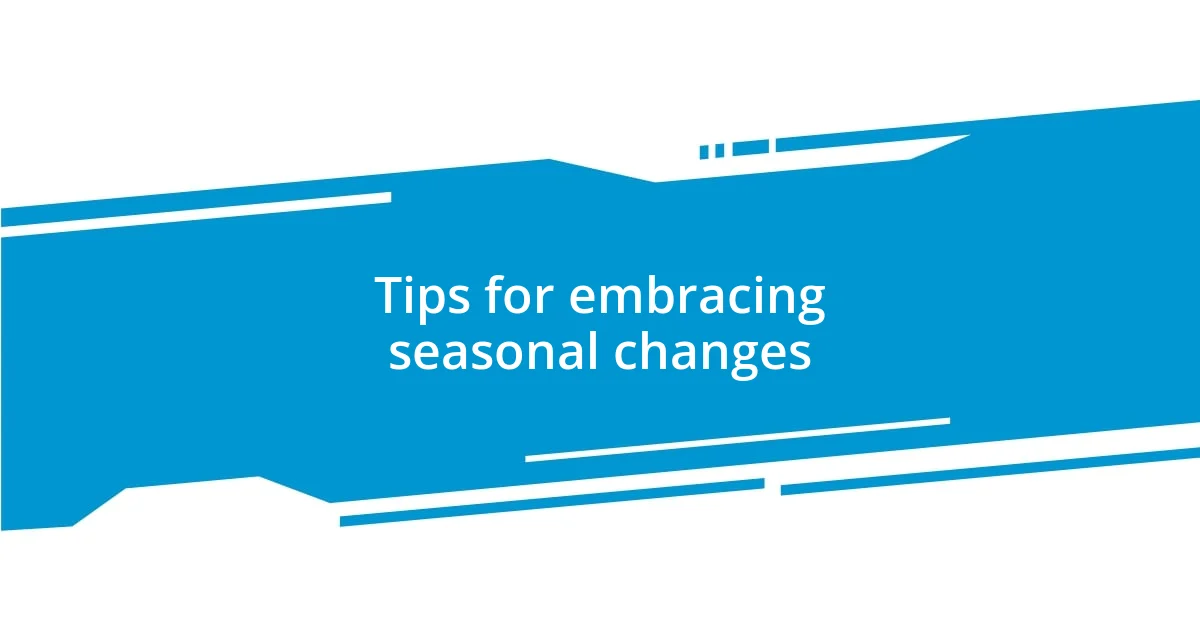
Tips for embracing seasonal changes
Embracing seasonal changes is about cultivating a mindset that reflects the fluidity of our environment. I remember when summer turned into fall, and I felt a compelling urge to switch my decor from vibrant hues to warm, earthy tones. It was a small but significant shift, creating a cozy atmosphere at home. How do we emotionally prepare for these transitions? For me, it involves not just physical changes but also reflecting on my experiences and adapting my goals, aligning them with the seasons.
Being in tune with nature’s rhythm can also inspire our fashion choices. One year, I decided to revamp my wardrobe as winter approached. I ventured into thrift shops, seeking unique pieces that spoke of warmth and comfort, blending nostalgia with practicality. This allows me to express my personality while embracing the seasonal vibes. Don’t you find that getting creative with your wardrobe can make the change feel exciting rather than daunting?
Finally, I believe that participating in seasonal events or traditions can enhance our appreciation for change. Last fall, I joined a local harvest festival, and it sparked a sense of community within me that I hadn’t expected. It was a powerful reminder of the joy that comes with seasonal festivities. Have you thought about how being part of these experiences can deepen your connection to the changing seasons? Engaging with your surroundings can turn what might feel like a burden into a beautiful celebration of life’s cyclical nature.















